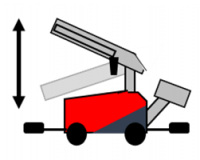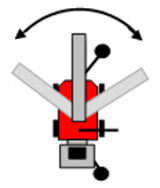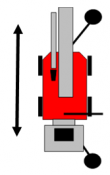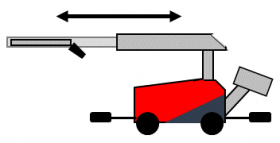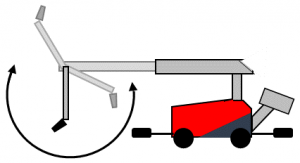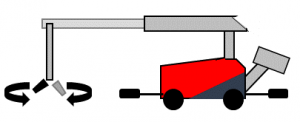Joystick - How to move the robot
You need the joystick to be able to program the EVO Cleaner. Here you can read on how the joystick works and how the robot moves.
The joystick is connected to the black socket, which can be found under the hood on the rear right-hand side of the cleaning robot. The plug must be turned 90 degrees for secure tightening when connected.
The joystick has a shaft that can be moved in four directions.
The button on top (closest to the shaft) opens and closes the water calve.
The two buttons on the side (1 and 2) activates different functions when held down (see further down).
The joystick can only run during the teach-in (recording) process and when the manual screen is shown. Otherwise the joystick is blocked for usage. We recommend to practice with the joystick in the manual screen to get more comfortable with the movements.
Link: Exploded view of the joystick.
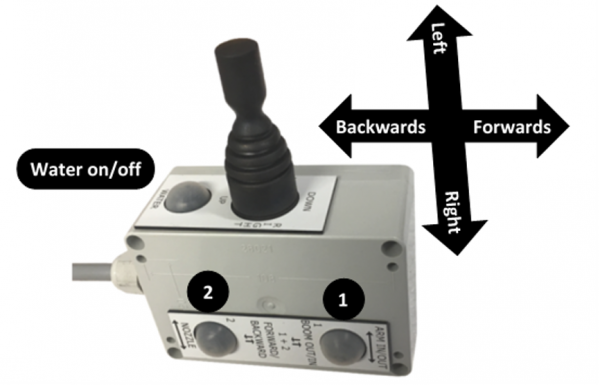
The EVO Cleaner's movements
General information
Some motions are more demanding for the robot than others. The fact that a motion is demanding means greater strain on the electric motor but also greater power consumption, which leads to higher battery consumption.


- Long movements with the boom up and down when the telescope is in a position far out. The further out the telescope is, the heavier it gets for the boom motor.
- Telescope out when the boom is in an upward position.
- Do not turn the tower sideways when the water/nozzle is sideways. If the water goes sideways when the tower rotates, the water pressure will effect the electric motor. The further out the telescope/arm is, the higher the effect gets.
Therefore, it is important that you use our principles as basics during the programming to get the full potential of the robot without unnecessary movements and with the least possible wear on the EVO Cleaner.
Basically we use a lot of motions with the tower, arm and nozzle to make circular patterns in our programs (most efficient). Boom, telescope and wheels is mostly used to take a new position (shorter movements).


The directions of motion in the following illustrations are described as seen from behind the robot.
Boom up/down
The boom moves about 100° from bottom (position 0) to top (position 1250). Parked position should be horizontal (about position 700).
Move joystick shaft backwards/forwards.
The tower can go about 200° in both directions (positions ±1000) from its parked forward position (about position 0).
Move joystick shaft right/left.
This function count the distance (pulses) from the markers to get its positions.
Move joystick shaft forwards/backwards, while pressing buttons 1 and 2 simultaneously.
The telescope can run out of its parked position 0 to position 425.
Move joystick shaft forwards/backwards, while pressing button 1.
The arm starts from its parked position parallel to the boom (position about -55). The arm can go out about 315°(to position 1100), so it points towards the ceiling.
Move joystick shaft right/left, while pressing button 1.
The nozzle can spin 360° in both directions. The nozzle is parked when the arm is parked and nozzle points downwards.
Move joystick shaft right/left, while pressing button 2.
Now you know how to run the joystick.
How to use the joystick in the programs, go to Programming - How to move the robot. and select a titel.

